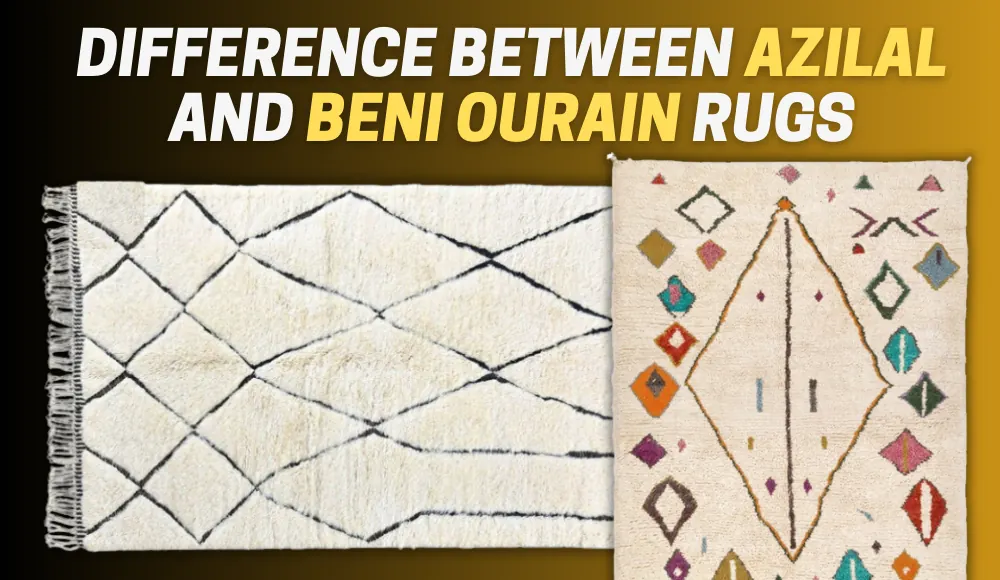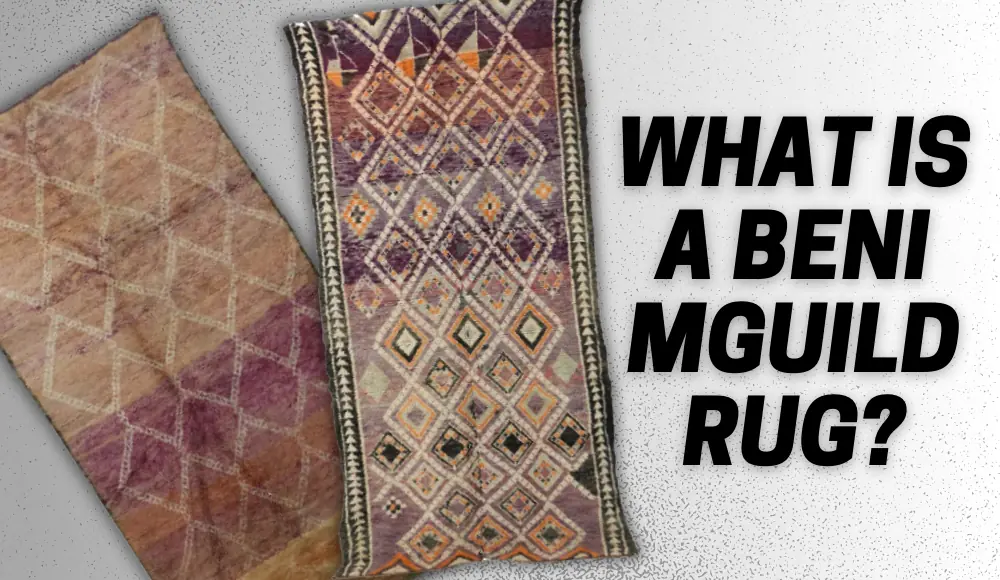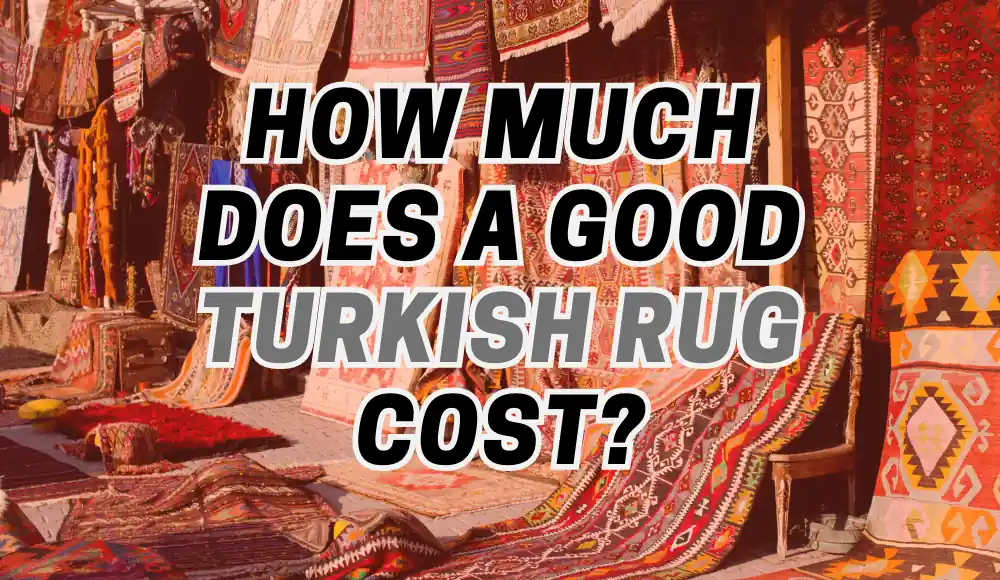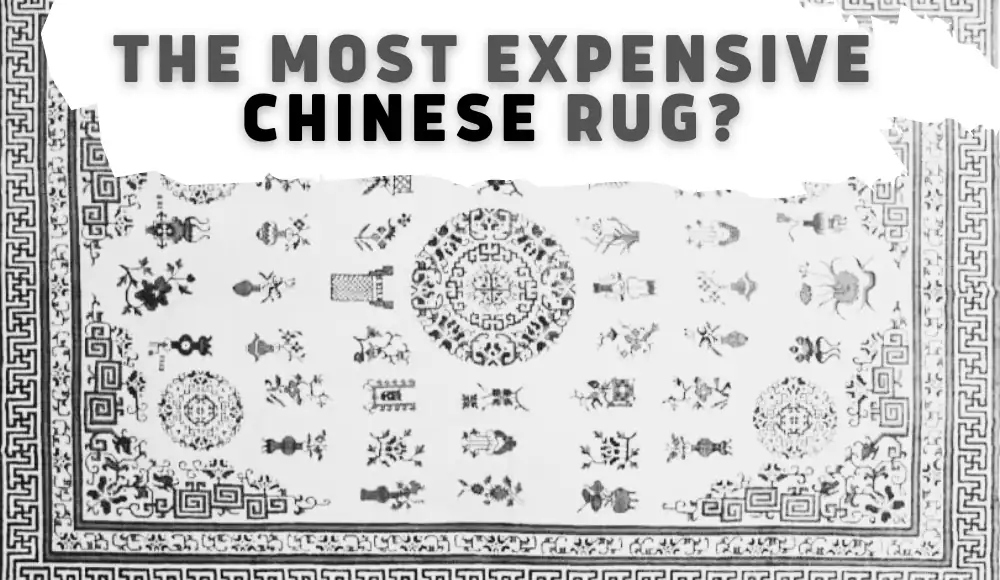Last updated on August 17th, 2023 at 05:56 am
Moroccan rugs have been a long-standing favorite of interior designers and homeowners alike. The intricate designs, vibrant colors, and exotic flair make them a unique addition to any home decor. However, with an abundance of Moroccan rug types available in the market, choosing the right one can be overwhelming for many. Among the popular ones are Azilal, Beni Ourain, and Beni Mrirt rugs. Today we will explain what is the difference between Azilal and Beni Ourain rugs.
Moroccan Rugs – A Popularity That Never Fades
Brief Explanation of the Popularity of Moroccan Rugs
The popularity of Moroccan rugs can be traced back to their rich history and cultural significance.
Morocco is home to various Berber tribes who have been hand-weaving these rugs for centuries using traditional techniques passed down from generation to generation.
These rugs are often used as prayer mats or floor coverings in homes, but their beauty has also made them highly sought after by collectors and decorators.
Furthermore, the rising trend towards eco-friendly and sustainable products has led many consumers to choose handmade Moroccan rugs over mass-produced synthetic ones. Not only are these rugs made from natural materials such as wool or cotton, but they are also free from chemicals that harm both humans and the environment.
Mention of Two Popular Types: Azilal and Beni Ourain
While there are countless types of Moroccan rugs available in the market today, two that stand out are Azilal and Beni Ourain.
These two types have gained immense popularity due to their unique characteristics that differentiate them from other types.
What is Moroccan Azilal rug?
Azilal meaning: Azilal rugs originate from the Azilal region in Morocco’s Atlas Mountains.

Where are Azilal rugs made?
Azilal rugs are traditionally made in the Atlas Mountains of Morocco about 180-200 km from Marrakech. The Berber people, known for their exquisite craftsmanship, create these unique and vibrant rugs using traditional weaving techniques.
Each Azilal rug tells a story of the weaver’s culture and heritage, with intricate patterns and vivid colors that add warmth and character to any space that reflect Berber culture’s symbolism.
On the other hand, Beni Ourain rugs come from specific tribes located on Morocco’s northeastern slopes of the Atlas Mountains.
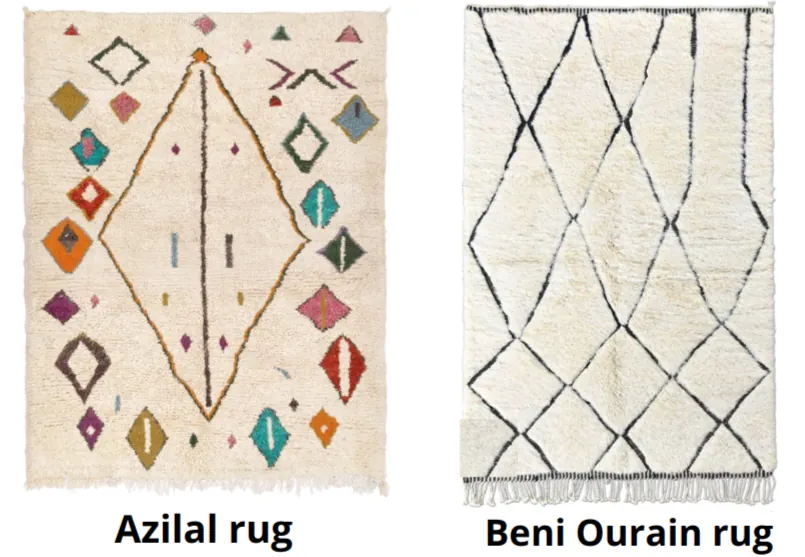
They are characterized by their geometric patterns and neutral color palettes. Now that we have a basic understanding of the popularity and significance of Moroccan rugs let’s dive deeper into what makes Azilal and Beni Ourain rugs unique, respectively.
The Unique Beauty of Azilal Rugs
Moroccan rugs have always been celebrated for their intricate designs, vibrant colors, and remarkable attention to detail. Among these prized carpets are the Azilal carpets and rugs, which are known for their abstract designs and colorful patterns.
The Berber women of the Azilal tribe in Morocco craft each rug by hand using natural wool and cotton materials.
What are Azilal rugs for the Berber?
The origins of Azilal rugs can be traced back hundreds of years ago when Berber tribespeople began weaving materials into practical items such as blankets and clothing. Over time, they began to incorporate more decorative elements into their designs resulting in the creation of beautiful carpets and rugs.
Azilal weavers draw inspiration from nature, often incorporating symbols that represent local flora or fauna into their designs. The geography and climate of the region also play a role in shaping the design aesthetic of these carpets.
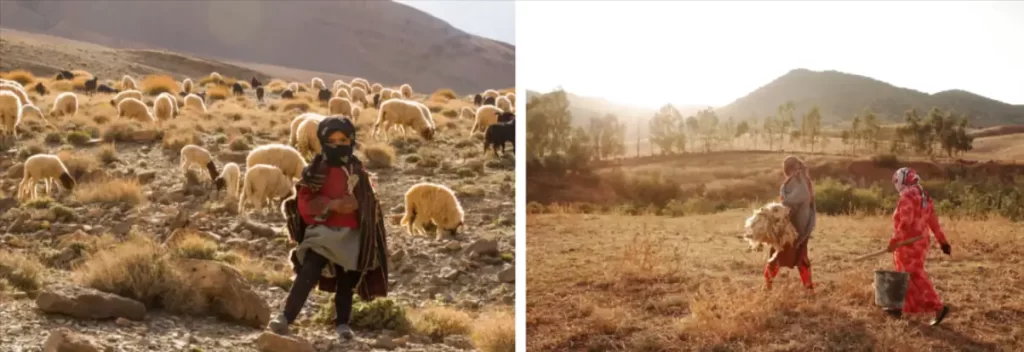
Azilal rugs are characterized by abstract patterns that are made from vibrant colors such as reds, yellows, purples, blues, and greens. Each rug is unique because it is handmade; no two are exactly alike.
The Berber women use techniques passed down through generations to create intricate motifs that tell stories about their culture or community history.
To identify an authentic Azilal rug look for color variations that blend naturally into one another; this is a hallmark characteristic indicative of hand-dyed wool fibers characteristic of these types of rugs.
Beni Ourain Rugs
Origins and History of Beni Ourain Rugs
Beni Ourain rugs have a rich history, dating back centuries to the indigenous Berber tribes of Morocco.
The Beni Ourain people are a tribe that lives in the Atlas Mountains, and they have been weaving these beautiful rugs by hand for generations.
Traditionally, these rugs were used as bedding to keep the Berber people warm during cold winter nights, but they have since become fashionable household accessories all over the world.
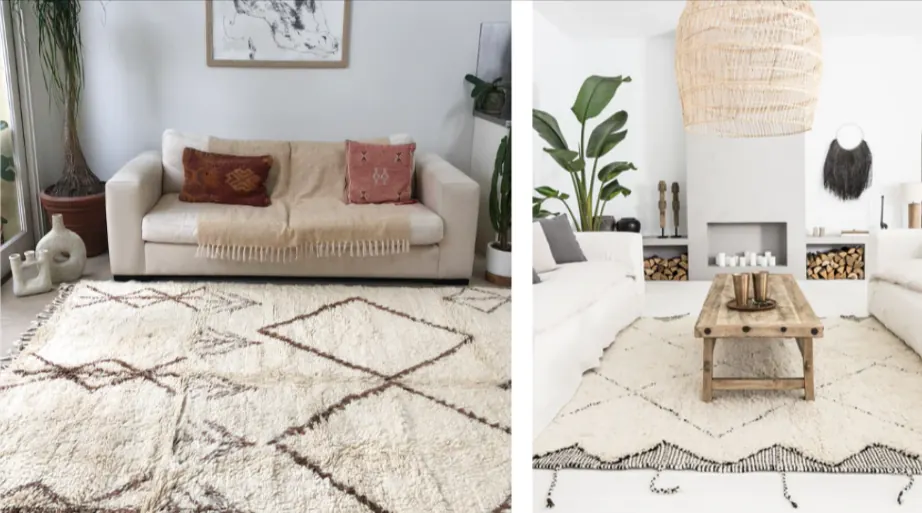
Characteristics:
A distinctive feature of Beni Ourain rugs is their neutral colors and geometric designs. These rugs usually come in shades of white or cream with bold black lines outlining intricate diamond shapes, triangles, or squares.
Some Beni Ourain rugs incorporate other natural colors such as browns or grays but these are typically quite subdued compared to other Moroccan rug styles.
In addition to their unique patterns and color schemes, another notable characteristic of these rugs is that they are made exclusively by female members of the Berber tribe.
The women use traditional looms and techniques passed down through generations to create each individual rug. Each rug takes several weeks to months depending on its size.
Materials Used:
Beni Ourain rugs are made from wool sheared from sheep in the Atlas Mountains.
The wool is thick and durable making it perfect for keeping warm during cold winter nights while also allowing it to endure daily wear and tear with ease.
Another unique feature about Beni Ourain wool is that it’s not dyed very often so you can expect natural hues such as cream/white with black designs instead of dyed colors.
How to Identify an Authentic Beni Ourain Rug:
It can be difficult at times for non-experts to differentiate between authentic handmade Beni Ourain rugs and cheaper, machine-made knockoffs. However, there are some telltale signs to look for when identifying an authentic Beni Ourain rug. We have already talked about this issue in detail here.
- First, check the wool; it should be thick and soft to the touch. The wool of a genuine Beni Ourain rug will never be too thin or have a synthetic feeling.
- Secondly, inspect the design patterns carefully. Authentic Beni Ourain rugs always feature geometric patterns that have a fluidity to them – almost as if they were drawn by hand.
- Look for imperfections in the weave and design of the rug – these are signs that the piece was hand-woven. Imperfections include slight irregularities in lines or shapes and subtle color variations which make each piece unique.
Key Differences in Design Elements Between Azilal and Beni Ourain
One of the most noticeable differences between Azilal and Beni Ourain rugs is their color scheme. Azilal rugs are known for their bright and bold colors, which are often created using natural dyes made from plants and minerals found in Morocco.
In contrast, Beni Ourain rugs typically feature neutral colors such as beige, ivory, black, and brown. This is because they are made from natural wool that has not been dyed.
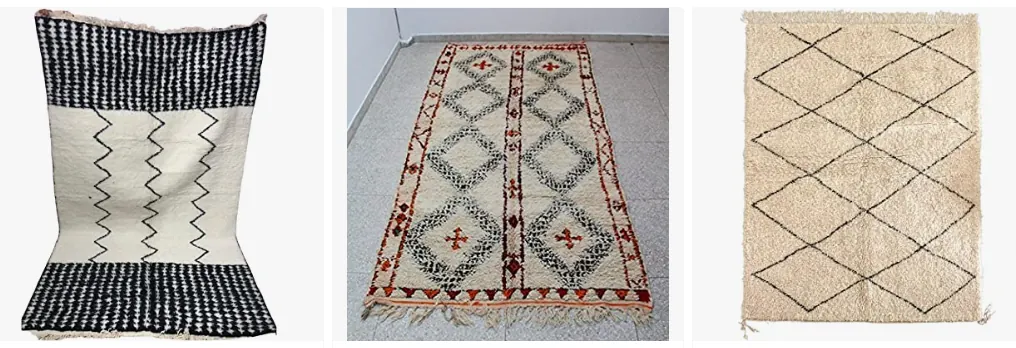
Another key difference lies in their patterns. Azilal rugs are known for their abstract designs featuring geometric shapes and free-flowing lines.
The designs often tell a story or represent something meaningful to the Berber women who make them. On the other hand, Beni Ourain rugs feature more traditional geometric patterns such as diamonds and triangles that have been passed down from generation to generation.
The shapes and sizes of Azilal and Beni Ourain rugs can also differ. Azilal rugs can often be made smaller in size, for instance ranging from 3×5 feet to 6×9 feet, while Beni Ourain rugs can be much larger with sizes ranging from 6×9 feet to 10×14 feet or even larger.
Differences in Materials Used
Azilal and Beni Ourain rugs also differ in the materials used to make them. Azilal rugs use natural wool as well as cotton for the warp (the vertical threads), which gives them a softer texture compared to other Moroccan rug types like Beni Ourain.
In contrast, authentic Beni Ourain rugs only use high-quality wool that’s sourced only from sheep living in Atlas Mountains regions where they produce wool with a relatively high lanolin content that creates a softer feel than ordinary wools do when it’s woven into fabrics like carpets or blankets.
The distinct materials used also affect the durability of each rug.
Beni Ourain rugs are known to be thicker and more hard-wearing, making them ideal for high-traffic areas in the house. Meanwhile, Azilal rugs may not be as durable due to their softer texture and lighter weight.
Key Differences Between Azilal and Beni Ourain Rugs
| Aspect | Azilal Rugs | Beni Ourain Rugs |
|---|---|---|
| Color Scheme | Bright and bold colors | Neutral colors (beige, ivory, black, brown) |
| Patterns | Abstract designs with geometric shapes | Traditional geometric patterns |
| Size Range | Smaller sizes (3×5 ft to 6×9 ft) | Larger sizes (6×9 ft to 10×14 ft or larger) |
| Materials | Natural wool and cotton for the warp | High-quality wool sourced from Atlas Mountains regions |
| Durability | Softer texture, lighter weight | Thicker and more hard-wearing |
Similarities between Azilal and Beni Ourain Rugs
Handmade by Berber Tribes in Morocco
One of the most striking similarities between Azilal and Beni Ourain rugs is that they are both handmade by Berber tribes in Morocco.
Handcrafting rugs is a centuries-old tradition in Berber culture, passed down from generation to generation. The art of rug-making is an essential part of their daily life, as it allows them to create functional objects that can be used for warmth and comfort in their home while also expressing their cultural identity.
Both Azilal and Beni Ourain rugs are made using traditional techniques that are specific to each tribe. Berber women use a loom to weave wool into intricate patterns, while men shear the wool from sheep raised in the Atlas Mountains.
This process requires skill, patience, and attention to detail. The result is a unique, high-quality rug that reflects the personality and creativity of its maker.
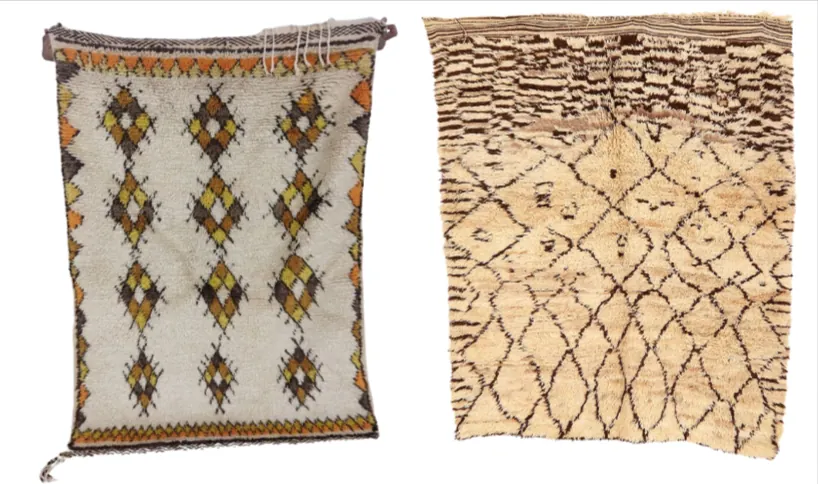
Using Natural Materials: Eco-Friendly Beauty That Lasts
Another similarity between Azilal and Beni Ourain rugs is their use of natural materials.
Both types of rugs are crafted from wool sourced from sheep raised on the Atlas Mountains or plains surrounding each tribe’s village. This means that they do not contain synthetic fibers or chemicals commonly used in industrial manufacturing.
The natural fibers used in these rugs provide excellent insulation against cold temperatures while allowing airflow during warm weather.
Wool also has antibacterial properties that help repel dirt, dust mites, and other allergens making them hypoallergenic.
With proper care (which includes regular vacuuming), these rugs can last for generations without losing their beauty or functionality. Both Azilal and Beni Ourain rugs embody a rich tradition of craftsmanship and an eco-friendly approach to rug-making.
They are a testament to the creativity and resourcefulness of Berber tribes in Morocco, who have been making rugs for centuries.
Whether you prefer colorful abstract designs or neutral geometric patterns, both Azilal and Beni Ourain rugs offer a unique blend of beauty, durability, and cultural significance that makes them a worthy addition to any home.
Key Similarities Between Azilal and Beni Ourain Rugs
| Aspect | Azilal Rugs | Beni Ourain Rugs |
|---|---|---|
| Handmade by Berber Tribes | Both handmade by Berber tribes in Morocco | Both handmade by Berber tribes in Morocco |
| Traditional Techniques | Made using traditional techniques specific to each tribe | Made using traditional techniques specific to each tribe |
| Wool from Atlas Mountains | Wool sourced from sheep raised in the Atlas Mountains | Wool sourced from sheep raised in the Atlas Mountains |
| Natural Materials | Crafted from natural wool without synthetic fibers or chemicals | Crafted from natural wool without synthetic fibers or chemicals |
| Eco-Friendly | Natural materials provide insulation and are hypoallergenic | Natural materials provide insulation and are hypoallergenic |
| Lasting Beauty | With proper care, they can last for generations | With proper care, they can last for generations |
| Cultural Significance | Reflect the creativity and cultural identity of the Berber tribes | Reflect the creativity and cultural identity of the Berber tribes |
How do you care for an Azilal rug?
To care for an Azilal rug and ensure its longevity, follow these simple steps:
- Regular Vacuuming: Use a vacuum cleaner with a brush attachment to gently remove dust and debris from the rug’s surface. Vacuum in the direction of the pile to avoid damaging the fibers.
- Spot Cleaning: Treat spills and stains immediately to prevent them from setting. Blot the affected area with a clean, damp cloth using a mild detergent or carpet cleaner. Avoid rubbing or scrubbing vigorously, as this can cause the colors to bleed.
- Air Dry and Sunlight: If your Azilal rug gets wet, allow it to air dry naturally in a well-ventilated area. Avoid direct sunlight, as prolonged exposure can fade the vibrant colors. Flip the rug occasionally to ensure even drying.
- Rotate Regularly: To prevent uneven wear and fading, rotate the rug periodically. This helps distribute foot traffic and sunlight exposure across different areas of the rug.
- Professional Cleaning: For deep cleaning or stubborn stains, it’s best to consult a professional rug cleaner who specializes in handling delicate, handmade rugs like Azilal. They have the expertise and equipment to ensure a thorough clean without damaging the rug.
- Gentle Brushing: Occasionally, you can use a soft-bristle brush or a handheld broom to gently brush the rug in the direction of the pile. This helps revive the fibers and maintain their softness.
For more detailed tips on cleaning wool Moroccan rugs read our article here.
Remember, Azilal rugs are unique pieces of art, so treat them with care and respect. By following these care tips, you’ll preserve the beauty and quality of your Azilal rug for years to come, allowing its story to unfold in your home.
Conclusion
Both Azilal and Beni Ourain rugs are incredibly beautiful and unique in their own way, with a rich history and cultural significance. It’s important to note that there is no “better” option between the two; rather, it comes down to personal preference and the overall look you’re trying to achieve in your home decor.
Recap of Differences and Similarities
Azilal rugs are known for their colorful, abstract designs made by Berber women using natural wool and cotton materials.
On the other hand, Beni Ourain rugs have neutral colors with geometric patterns made by Berber tribes using natural wool sourced from sheep in the Atlas Mountains of Morocco.
The key differences between Azilal and Beni Ourain rugs lie in their design elements such as color schemes, patterns, shapes, sizes as well as materials used.
Despite these differences, both types of rugs share similarities including being handmade by Berber tribes using traditional techniques passed down through generations. Both also use natural materials making them eco-friendly options for home decor enthusiasts.
Personal Recommendation Based on Individual Preferences
If you’re looking for a statement piece that will liven up your space with bold colors and intricate designs, then an Azilal rug is definitely worth considering. These unique pieces can add a touch of playful character to any room in the house.
If you’re going for a more understated look that still provides texture and depth to your space then it might be worth considering a Beni Ourain rug. Their subtle geometric patterns blend seamlessly into any decor style making them versatile options for those who like to change things up often.
Overall, Moroccan rugs are a great investment for anyone who values quality craftsmanship along with rich historical significance that adds character to the spaces they reside in.
